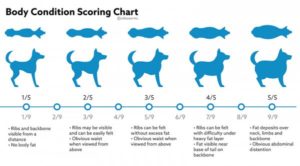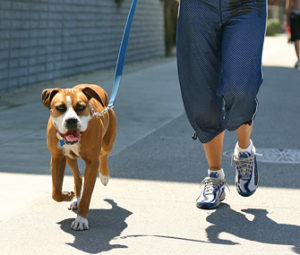Obesity is defined as an excess accumulation of body fat. It can often be difficult to identify if your pet is overweight due to the fact that it occurs gradually and over time. If you are used to seeing your pet everyday, noticing these slow changes may be innocently overlooked without even thinking about it. According to statistics, approximately 25-30% of all pets are obese – that’s a pretty high number! There are many factors that may play a role in the tendency for cats and dogs to gain excessive weight, although one of the main contributors aside from medical concerns is lifestyle, including key factors such as diet and exercise.
What causes obesity?
There are a multitude of reasons why a pet may begin to gain some extra weight. The main cause is typically overeating and a lack of exercise although other factors may come into play as well. It is always important to rule out any potential medical causes of weight gain before proceeding to other potential factors.
Age
- As dogs and cats age their energy levels and therefore caloric needs decrease over time. Feeding the proper amount and a diet that is specifically formulated for each pet’s specific life stage is vital to their health and wellbeing.
Breed
- Some breeds are more predisposed to developing obesity. These dog breeds may include Labrador Retrievers, Bulldogs, Pugs, Basset Hounds, Beagles and Dachshunds among others.
Type of food
- As previously stated, each pet should be fed a food tailored to their specific lifestyle. For example, a 4 year old German Shepherd may experience weight gain if he is consuming a puppy/growth food as it is more calorie dense. On the other hand, if the same dog was being fed a diet geared towards senior pets he may experience weight loss as he is not ingesting enough calories for his current life stage and activity level. Not only does feeding the proper food affect weight, but it also prevents other medical issues as well by providing the correct quantity and quality of nutrients. If these nutrient needs are unbalanced or not met – more than just your pet’s weight can be affected.
- Feeding human food or table scraps to your pet may also have a negative effect on health and wellbeing.
Overfeeding/Overeating
- Free feeding may often result in overeating. Sometimes your pet may not be hungry but will continue to eat as there is an unlimited amount of food in front of them. If your pet does not have enough physical and mental stimulation in their life, overeating may also be due to boredom.
- Some pets will also choose to eat more if they are fed commercial diets that are filled with lots of added sodium and other fatty ingredients that increase palatability. This may encourage them to eat more, causing weight gain and medical problems down the line.
Medical Issues
- A wide array of medical issues can be linked to obesity which is discussed in the next section, “risks of obesity.”
Sex Alteration
- Scientific studies have been shown that spaying and neutering pets may decrease their metabolic rate which therefore means that they will require less calories. This is not suggesting by any means not to spay or neuter your pets because the medical and behavioural benefits will typically outweigh the risks (depending on each individual pet), this point is just to create awareness that spayed or neutered pets may require less ingested calories which potentially correlates to feeding them less than an unaltered pet.
Risks of Obesity:
Obesity can decrease the quality and longevity of your pet’s life. Pets who are overweight are predisposed to developing health problems. A few pounds may seem harmless at first, although a variety of negative health effects can occur when the pet is as little as 20% overweight.
Some of the negative health effects on pets may include the development of the following conditions:
- Many types of cancer
- Diabetes mellitus
- Pancreatitis (specifically from feeding fatty foods)
- Cardiovascular Disease
- CCL tears in dogs
- Hypertension (high blood pressure)
- Osteoarthritis and a faster degeneration of affected joints (due to the heavy strain on the joints)
- Urinary bladder stones
- Anesthetic complications (Heat Intolerance)
Alternatively, unexplained weight gain in older canines may also be a sign of other underlying conditions such as Cushing’s disease (Hyperadrenocorticism), or hypothyroidism. It is always important to rule out potential medical problems first if you are concerned that your pet may be obese.
How do you know if your pet is obese?
In veterinary medicine, we use what is called a Body Condition Score (BCS) to initially identify the ideal weight of a specific patient. The BCS is very similar to the BMI scale (Body Mass Index) in humans. Your veterinarian will use visualization, body measurements and palpation of your pet to determine their personalized BCS score with individual size and breed factors in mind. The ribs of your pet should easily be felt upon palpation, just underneath a thin layer of fat.

Other signs of obesity to consider:
- Slow movement
- Shortness of breath during rest or mild exercise
- Increased sleeping
- Collar/harness requires frequent loosening
- Difficulty walking
- Swallowing food rapidly, with minimal or no chewing
Prevention and Management:
There are many things that you can do to prevent your pet from gaining excessive weight while maintaining a healthy lifestyle. Discuss with your veterinarian what the proper next steps are for your pet!
Prevention and management tips to consider:
- Exercise with your pet: Make sure they are meeting their daily requirements in order to burn additional calories and maintain a healthy lifestyle. Exercising with your dog by going on walks, runs, or playing fetch can be a fun activity that will increase bonding and overall happiness! Engaging in play with your cat is also a great activity stimulator, using toys incorporated with catnip is great for enticing play behaviour. Scratching posts are also a great way to motivate your cat to burn some extra calories.
- Choose the right food for your pet: Every individual pet will have different nutritional requirements based on lifestyle, age, breed and medical conditions. Speak with your veterinarian about which food is right for your pet!
- Limit treats: Treats should only be about 10% or less of your pet’s daily caloric intake.
- Eliminate or reduce human food/table scraps
- Meal Feeding: By giving your pet a certain calculated amount of food at each meal you are able to control and monitor how much they are eating. This is definitely a better feeding method when looking at weight loss prevention as it is difficult to monitor or control the amount your pet eats if they have access to a constant supply of food.


Please visit the Fear Free Happy Homes website to discover more weight loss tips and tricks! We would like to encourage all pet parents to aid in reducing pet anxiety during the weight loss experience!

For more information about your specific pet’s needs please feel welcome to contact us here at Close Veterinary Clinic, we will be more than happy to assist you in creating a plan to ensure your pet meets their ideal weight while maintaining their health and wellbeing!

